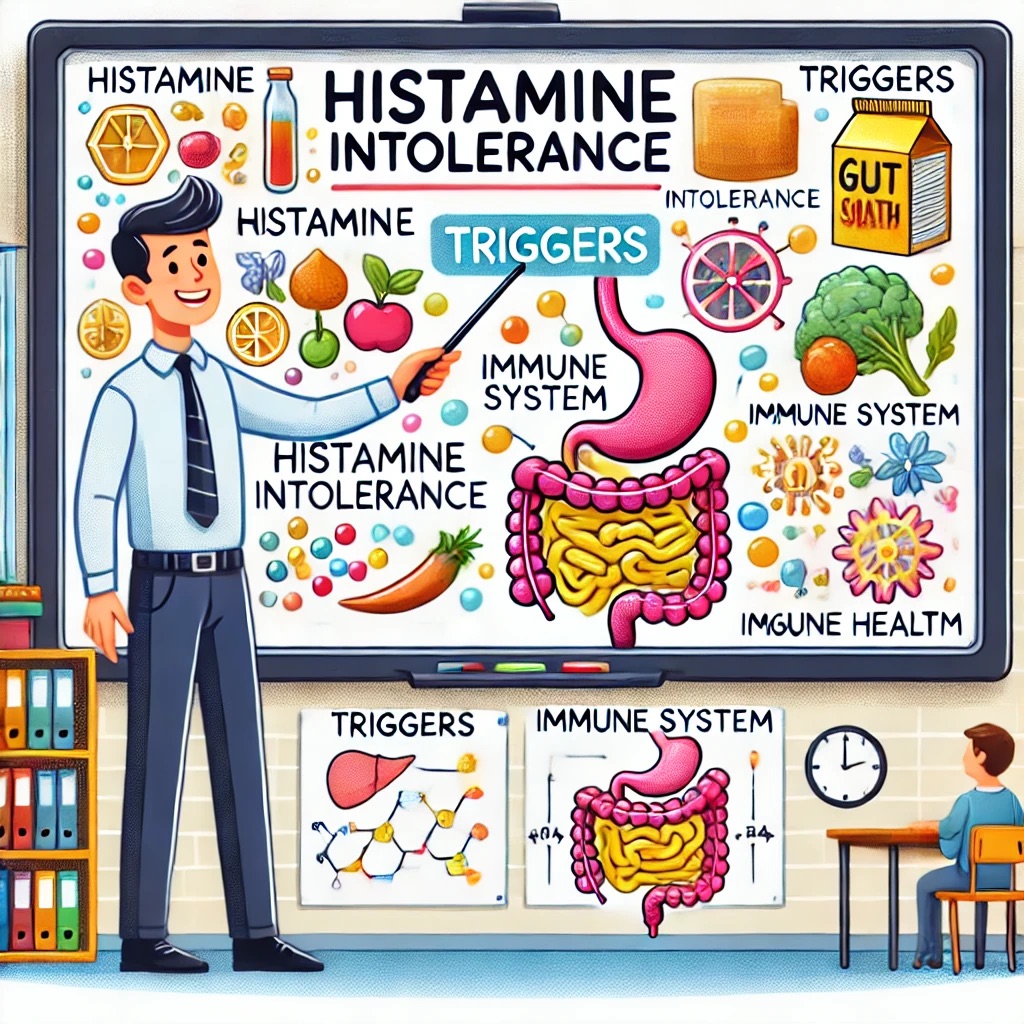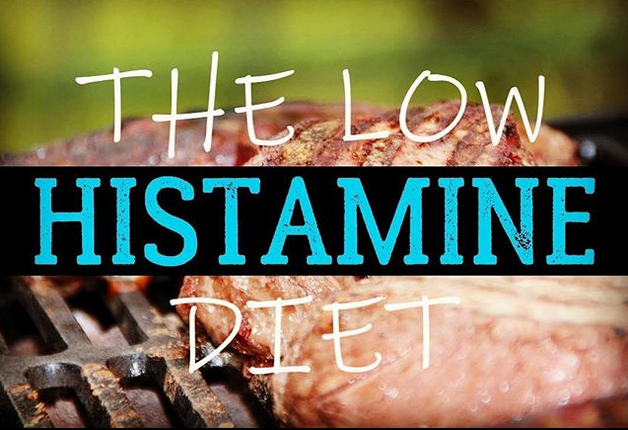Histamine Intolerance – Simplified for Beginners
 Histamine intolerance affects a significant number of individuals worldwide yet remains underdiagnosed and misunderstood. If you’ve ever wondered why certain foods make you feel unwell or experience unexplained symptoms after eating, histamine intolerance could be the culprit. This article dives deep into histamine intolerance, exploring its causes, symptoms, diagnosis, and effective management strategies, all backed by scientific research.
Histamine intolerance affects a significant number of individuals worldwide yet remains underdiagnosed and misunderstood. If you’ve ever wondered why certain foods make you feel unwell or experience unexplained symptoms after eating, histamine intolerance could be the culprit. This article dives deep into histamine intolerance, exploring its causes, symptoms, diagnosis, and effective management strategies, all backed by scientific research.
What is Histamine Intolerance?
Histamine is a critical compound that plays a role in various body systems. It influences digestion, communication between the brain and the body, and much more. It is also present in various foods. However, when histamine accumulates in the body beyond a certain threshold, it can lead to various symptoms—a condition known as histamine intolerance.
Unlike a true food allergy, where the immune system overreacts to a specific allergen, histamine intolerance occurs when the body cannot efficiently break down histamine. This inefficiency leads to an excessive buildup of histamine in the body, causing symptoms that resemble an allergic reaction.
The Role of Diamine Oxidase (DAO) in Histamine Metabolism
Diamine oxidase (DAO) is the key enzyme that breaks down ingested histamine. DAO is produced primarily in the intestines and is crucial for metabolizing histamine from food. If DAO activity is impaired or insufficient, histamine levels can rise, leading to histamine intolerance symptoms.
Several factors can influence DAO activity, including genetics, gastrointestinal health, and the consumption of certain medications that inhibit DAO function. Scientific studies have shown that low levels of DAO are a significant risk factor for developing histamine intolerance.
Symptoms of Histamine Intolerance: More Than Just an Allergy
The symptoms of histamine intolerance can be diverse and often overlap with other conditions, making diagnosis challenging. Common symptoms include:
1. Headaches and Migraines: Histamine can dilate blood vessels, leading to headaches and migraines.
2. Digestive Issues: Abdominal pain, bloating, diarrhea, and nausea are frequent complaints among histamine intolerance patients.
3. Skin Reactions: Hives, itching, tingling, and flushing are common skin-related symptoms.
4. Respiratory Problems: Nasal congestion, sneezing, and shortness of breath may occur, mimicking allergic rhinitis.
5. Cardiovascular Symptoms: Palpitations, rapid heartbeat, and low blood pressure can also result from histamine intolerance.
6. Menstrual Irregularities: Histamine can influence hormone levels, potentially causing menstrual irregularities in women.
Given this wide range of symptoms, it’s easy to see why histamine intolerance is often mistaken for other conditions, such as food allergies, irritable bowel syndrome (IBS), or even anxiety disorders.
The Science Behind Histamine Intolerance
Several studies have proven that histamine intolerance is prevalent in the population.
A 2011 American Journal of Clinical Nutrition study explored the relationship between histamine levels in the body and migraines. The researchers found that individuals with low DAO activity were more likely to suffer from migraines after consuming foods high in histamine, suggesting a direct link between histamine intolerance and certain types of headaches.
Another 2013 study from The Journal of Allergy and Clinical Immunology investigated the prevalence of histamine intolerance in individuals with chronic urticaria (hives). The study concluded that patients with chronic hives often had reduced DAO activity, leading to higher histamine levels and more severe symptoms.
Moreover, a study published in Gastroenterology in 2018 found that histamine intolerance might be underdiagnosed in patients with gastrointestinal disorders like IBS. The study suggested that improving DAO activity through dietary changes and supplements could significantly reduce symptoms in these patients.
What Causes Histamine Intolerance?
Histamine intolerance can result from several factors, many of which are interconnected. Here are the primary causes:
1. Genetic Factors: Some people are genetically predisposed to low DAO activity, making them more susceptible to histamine intolerance.
2. Gastrointestinal Disorders: Conditions like leaky gut syndrome, small intestinal bacterial overgrowth (SIBO), and inflammatory bowel disease (IBD) can impair DAO production and function.
3. Medications: Certain medications, including antibiotics, antidepressants, and antihistamines, can inhibit DAO activity or increase histamine levels, exacerbating symptoms.
4. Hormonal Imbalances: Histamine can interact with hormones like estrogen, which is why some women experience worsening symptoms during menstruation or pregnancy.
5. Dietary Factors: A diet high in histamine-rich foods can overwhelm the body’s ability to break down histamine, leading to symptoms. Foods high in histamine include aged cheeses, fermented foods, alcohol, and certain types of fish.
6. Mold Sensitivity: Mold intolerance can cause mast cells to secrete abnormal amounts of histamine into the blood, making you more reactive to everything else your body consumes or inhales.
Diagnosing Histamine Intolerance: Challenges and Methods
Diagnosing histamine intolerance can be tricky due to the overlap of symptoms with other conditions. However, several diagnostic methods can help identify the condition:
1. DAO Activity Test: Measuring DAO activity in the blood can provide insight into whether low enzyme levels might contribute to histamine intolerance. Low DAO levels are often indicative of the condition.
2. Histamine Challenge Test: This test involves consuming a histamine-rich diet or taking a histamine supplement under medical supervision to observe if symptoms worsen.
3. Elimination Diet: An elimination diet, where high-histamine foods are removed from the diet and then gradually reintroduced, is the most effective method for quickly reducing histamine intolerance symptoms. This allows you to tailor your diet based on the foods that agree with your body.
4. Skin Prick Test: Though more commonly used for allergies, this test can sometimes be used to assess histamine reactions in the skin.
Due to the complexity of the condition, a combination of these methods is often necessary for an accurate diagnosis.
Managing HIT through Diet, Lifestyle, and Supplements
While there’s no cure for histamine intolerance, effective management can significantly reduce symptoms. The following strategies are commonly recommended:
1. Histamine-Lowering Diet: The most effective way to manage histamine intolerance is through diet. Avoiding or limiting high-histamine foods is crucial. These foods include aged cheeses, fermented foods, alcohol, smoked meats, and certain fish like tuna and mackerel. Additionally, foods that can trigger the release of histamine in the body, such as tomatoes, chocolate, and strawberries, should be consumed with caution. M
2. Supporting DAO Activity: Increasing DAO levels in the body can help manage histamine intolerance. This can be achieved through supplements that contain DAO or its cofactors, such as vitamin B6, copper, and zinc. A 2019 study published in Nutrients found that DAO supplementation significantly improved symptoms in individuals with histamine intolerance. Despite this, my experience has been that many clients do not do well with DAO supplements, so I would be careful.
3. Probiotics and Gut Health: Maintaining a healthy gut microbiome is crucial for managing histamine intolerance. Certain probiotics, like Lactobacillus rhamnosus, Bacillus subtilis DE 111, and Bifidobacterium longum, have been shown to support gut health and may reduce histamine production in the gut. It’s also important to address underlying gut issues, such as SIBO or leaky gut, which can exacerbate histamine intolerance.
4. Medications: In some cases, antihistamines may be prescribed to help manage symptoms, particularly for those who experience severe reactions. However, this should be done under the guidance of a healthcare professional, as long-term use of antihistamines can have side effects and may not address the root cause of the condition.
5. Stress Management: Stress can exacerbate histamine intolerance by increasing histamine release and reducing DAO activity. Slow deep breathing, mindfulness, yoga, and regular exercise can help manage stress levels and improve overall health.
Foods to Avoid: A Comprehensive List
Certain foods should be avoided or limited for individuals with histamine intolerance due to their high histamine content. Here is a list of foods to watch out for:
– Aged Cheeses: Parmesan, cheddar, Gouda, Swiss, and blue cheese
– Fermented Foods: Sauerkraut, kimchi, soy sauce, miso, tempeh, and kombucha
– Alcoholic Beverages: Red wine, champagne, and beer
– Processed Meats: Salami, pepperoni, bacon, and sausages
– Certain Fish: Tuna, mackerel, sardines, and anchovies
– Pickled Vegetables: Pickles, olives, and capers
– Vinegar-containing Products: Vinegar, pickles, mustard, and certain dressings
It’s also important to be aware that some foods, while not high in histamine themselves, can trigger histamine release from mast cells in the body. These include tomatoes, eggplants, avocados, spinach, and citrus fruits. For an even more detailed list, visit my article, The Low Histamine Diet—Ultimate Guide.
The Future of Histamine Intolerance Research
For example, some researchers are investigating the role of the gut microbiome in histamine intolerance, hoping that probiotics or other microbiome-modulating therapies could offer relief for those affected. Additionally, advances in nutrigenomics—the study of the interaction between nutrition and genetics—may lead to personalized dietary recommendations based on an individual’s genetic makeup. This approach could help tailor treatments and prevention strategies for histamine intolerance, potentially improving outcomes for those affected.
Another promising area of research is the development of more targeted supplements and medications that can either boost DAO activity or directly counteract the effects of histamine. Enzyme replacement therapies and new antihistamines with fewer side effects are also being explored as potential treatment options. Additionally, there has been a lot of research into mast cell modulators since they are the source of histamine release internally.
To learn more about some of the things I used to overcome histamine issues, read my article Top 10 Supplements for Histamine Intolerance.
Living with Histamine Intolerance: Practical Tips for Daily Life
For those living with histamine intolerance, managing the condition involves making mindful choices daily. Here are some practical tips:
1. Meal Planning: Plan meals to avoid high-histamine foods. Freshly prepared meals are generally safer, as histamine levels increase in leftovers, especially those containing protein.
2. Mindful Eating: Be aware of how your body reacts to certain foods. Keeping a food diary is essential. It can help you to identify triggers and track symptoms over time. Do NOT skip on this step, trust me!
3. Shopping Smart: Choose fresh, unprocessed foods when grocery shopping. Avoid canned, smoked, and fermented products, as these tend to have higher histamine content.
4. Cook Fresh: Try to eat meals immediately after preparation. If you must store leftovers, freeze them quickly to prevent histamine buildup.
5. Stress Reduction: Incorporate stress-reducing activities into your daily routine, such as slow, deep breathing, meditation, yoga, stretching, or walking. Reducing stress can lower histamine levels and improve overall well-being.
6. Rule Out Mold: If you have histamine intolerance or symptoms of mast cell activation, you are likely to be sensitive to mold. Even if you can’t see it, mycotoxins from mold can wreak havoc on your immune system.
7. Avoid Synthetic Supplements: People with histamine intolerance often become sensitive to vitamins and other supplements. It is essential to understand that less is better for the first few months until you get things under control.
8. Eat Mostly Plant-Based: You do NOT want to eat meat every day. This will never allow you to escape the histamine trap once and for all. You want to focus mostly on eating vegetables, fruits, beans, potatoes, rice, etc.
Conclusion: Taking Control of Histamine Intolerance
Histamine intolerance is a complex health condition that requires careful management, but individuals can lead healthy, fulfilling lives with the proper knowledge and strategies. Understanding the role of histamine in the body, recognizing the symptoms of a histamine response, and identifying the cause are the first steps toward effective management. This is best done through meticulous journaling of what you eat and all of your symptoms.
Those with histamine intolerance can significantly reduce their symptoms by adopting a low-histamine diet mainly focused on plant-based foods. Once they add the supplements after implementing this diet, the symptoms become much easier to control.
As research advances, the hope is that more effective treatments and possibly a cure for histamine intolerance will emerge. Until then, individuals can manage their condition through dietary adjustments, lifestyle changes, and targeted supplementation.
If you are having trouble with histamine intolerance, you are welcome to contact me. This is my niche, and I have plenty of experience that could be helpful for you. .
Happy healing everyone!
Matt Nedin, B.S.
Certified Holistic Nutritionist
EndSickness.org
Phone: (734) 846-8619
WhatsApp: +17348468619
Email: endsickness@gmail.com
References
1. Maintz, L., & Novak, N. (2007). Histamine and histamine intolerance. American Journal of Clinical Nutrition, 85(5), 1185-1196.
2. Bohn, L., Storsrud, S., Liljebo, T., Collin, L., Lindfors, P., & Törnblom, H. (2018). Histamine intolerance in patients with irritable bowel syndrome: A retrospective review. *Gastroenterology, 154*(1), 82-90.
3. Izquierdo-Casas, J., Comas-Basté, O., Latorre-Moratalla, M. L., Lorente-Gascón, M., Duelo, A., & Vidal-Carou, M. C. (2019). Low serum diamine oxidase (DAO) activity levels in patients with migraine. *Nutrients, 11*(9), 2015.
4. Guida, F., De Gregorio, D., Palange, I., Alcaro, S., Piomelli, D., & Iannotti, F. A. (2020). Histamine, histamine receptors, and endocannabinoids in histamine intolerance: A novel approach to understanding an old problem. Frontiers in Neuroscience, 14, 680.
5. Comas-Basté, O., Sánchez-Pérez, S., Veciana-Nogués, M. T., Latorre-Moratalla, M. L., & Vidal-Carou, M. C. (2020). Histamine intolerance: The current state of the art. Biomolecules, 10(8), 1181.
6. Reese, I., Ballmer-Weber, B., Worm, M., & Beyer, K. (2013). Chronic urticaria and histamine intolerance. Journal of Allergy and Clinical Immunology, 131(2), AB102.










